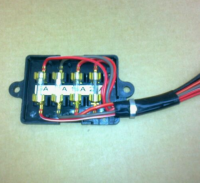It has been mentioned already regarding the tail light running direct via the 20A fuse. In the past some have lost all power to their bikes because of a short in this Blue wire. This wire to the tail light sees a lot of vibration which slowly wears through the insulation. My solution was to fit a single fuse in the headlight bucket to intercept the blue wire from the ignition switch. I know it is very cramped in the bucket but the fuse fitted OK.
It seems to me the horn is wired direct to the 20A fuse??
On another forum I saw a warning about bike horns. They draw a significant current, perhaps 6 - 12A depending on the type. You may want to have the horn on its own fuse or powered from a line that does not draw a high current i.e. I would not have the horn wired on the same line as the headlight with a 10A fuse.
It seems to me the horn is wired direct to the 20A fuse??
On another forum I saw a warning about bike horns. They draw a significant current, perhaps 6 - 12A depending on the type. You may want to have the horn on its own fuse or powered from a line that does not draw a high current i.e. I would not have the horn wired on the same line as the headlight with a 10A fuse.



